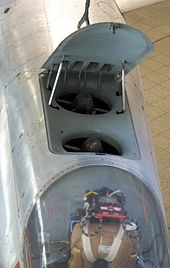EWR VJ 101
The intention was for the VJ 101 to eventually be developed as the basis for a successor for the German Air Force's inventory of American Lockheed F-104G Starfighter interceptors.
[2] During 1950s and 1960s, multiple programmes in Britain, France, and the United States were initiated; likewise, aviation companies inside West Germany were keen not to be left out of this emerging technology.
Shortly after 1957, the year in which the post-Second World War ban upon West Germany operating and developing combat aircraft was lifted, German aviation firms Dornier Flugzeugwerke, Heinkel, and Messerschmitt, having also been allowed to resume their own activities that same year, received an official request from the German Federal Government that urged them to perform investigative work on the topic of VTOL aircraft and to produce concept designs.
[4] Under the terms of the 10-year contract established, Germany would acquire knowledge of the latest advances in jet engine technology via Rolls-Royce, as well a joint-development arrangement under which work would be shared, production conflicts minimised, and mutual consensus reached on key decisions.
[6] Both Heinkel (based on Heinkel He 231)[7][8] and Messerschmitt (Messerschmitt Me X1-21)[9][10] had developed designs to meet the requirements of VTOL flight and by 1959, the two companies, along with Bölkow, had created a joint venture company, called EWR, to develop and manufacture an envisioned supersonic fighter aircraft, designated as the VJ 101 D. As conceived, the production VJ 101 D aircraft was to be powered by the Rolls-Royce/MAN Turbo RB153 engine, which was to be equipped with thrust deflection apparatus.
[12] After performing a review of the proposal, the BMVg decided to issue an order for two experimental aircraft with a view to evaluating their ability towards fulfilling the standing interceptor requirement.
The VJ 101 C bore some similarities in appearance to the American Bell XF-109, both aircraft having a comparable configuration in terms of possessing paired engines fitted within swivelling nacelles which were positioned at their wingtips.
[15] It was realised that it would be of critical importance to maintain controllability during the hover phase of flight, in particular the responsiveness of the engines and augmentation of the aircraft's stability.
The simple device incorporated a rudimentary cockpit fixed upon a horizontal beam, which had a "lift" engine mounted vertically at the centre, for the purpose of performing preliminary single-axis tests of the control system.
[18] A later "hover rig" was assembled, which had the skeletal fuselage of the VJ 101C along with a total of three Rolls-Royce RB108 engines installed in the approximate positions that they would occupy in the final flight-capable version.
[19] Additional tests performed with a cloth "skin" to simulate the fuselage and wings proved to be successful as well, having demonstrated satisfactory control throughout all seasons and weather conditions.
In the course of these tests, the sound barrier was broken for the first time by a vertical takeoff aircraft; however, on 14 September 1964, a defect in the autopilot caused the X-1 to crash, sustaining some damage as a result.
While the VJ 101C did not proceed to production status, various other projects of the era to develop supersonic-capable VTOL fighter aircraft, including the Mirage IIIV and the Hawker Siddeley P.1154 (a supersonic parallel to what would become the Hawker Siddeley Harrier, a subsonic VTOL combat aircraft that reached operational service), ultimately met similar fates.



